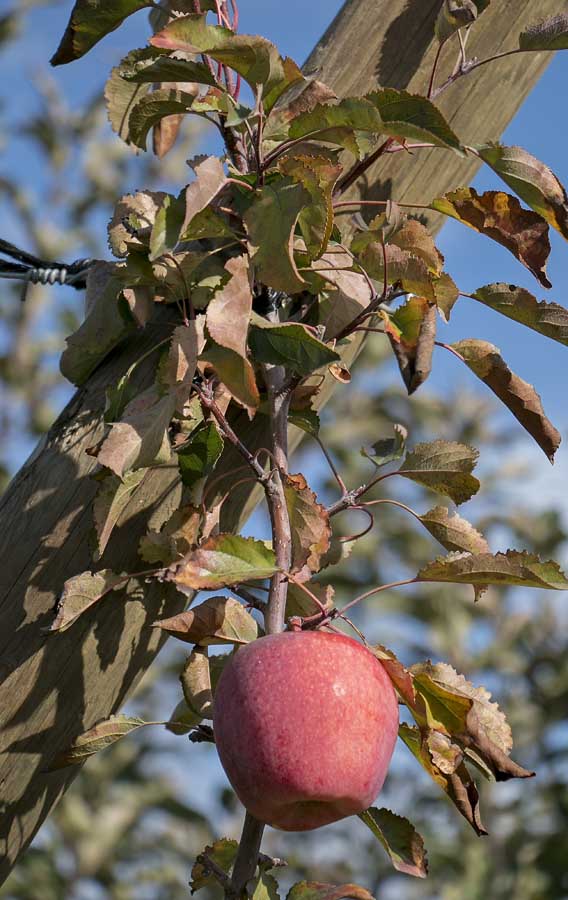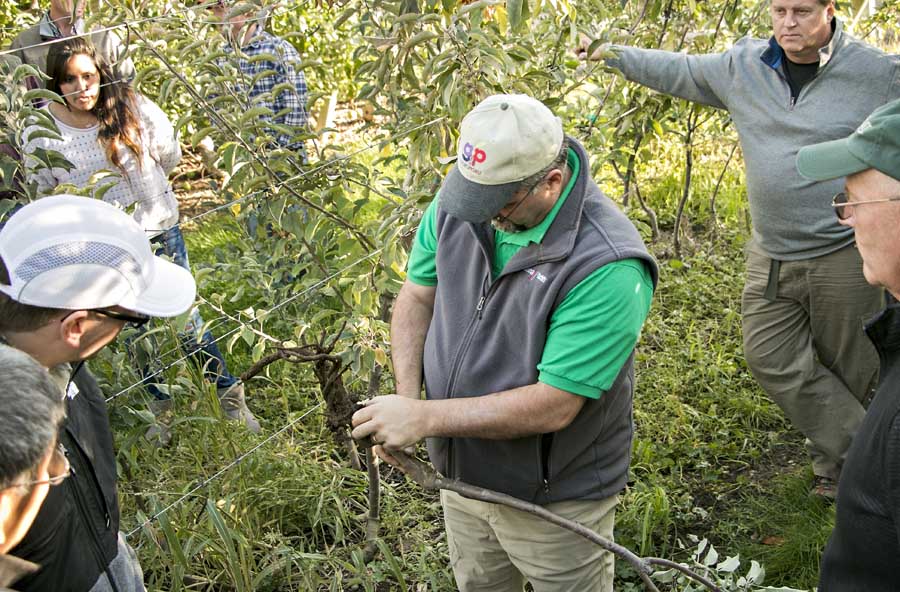
Oroville grower Dave Taber in front of a trial row of what used to be Royal Red Honeycrisps on Geneva 935 rootstock. He lost about 3,000 trees in the commercial portion of his orchard due to the troubled combination. (Ross Courtney/Good Fruit Grower)
Oroville, Washington, grower Dave Taber is relieved he didn’t plant more Royal Red Honeycrisp apples on Geneva 935 rootstocks.
As it was this year, he tore out 3,000 trees — two acres worth — from a commercial block after an unknown disorder left many of them stunted, small and sickly. Only a few of the trees reached the top wire of his trellis while the roots struggled to grow.
“We are quite small farmers. If we would have done that on the 30-some acres of high density that we did, it’d probably (darn) near break me,” Taber told a collection of about 60 growers and nursery owners visiting his North Central Washington orchard during a mid-October rootstock tour.
Certain strains of some varieties have been showing symptoms of tree decline on G.935, one of several new apple rootstocks released by Cornell University.
Both researchers and growers are noticing the problems, though they don’t have clear answers as to what’s causing them yet.
“As for the G.935 performance, yes, to the grower, I’m sorry,” said Gennaro Fazio, U.S. Department of Agriculture geneticist and breeder in Geneva, New York, shaking his head. “It was supposed to be the best thing.”
Then again, he feels just as sorry when entire orchards planted on Malling 9 rootstocks are pulled because of fire blight, he said.
The head-scratching problems may be an unintended consequence of the industry’s drive to renovate older orchards and increase the number of higher-value varieties with high-performing rootstocks.
The eight-member Geneva series rootstocks are noted for high precocity, improving tree growth on replant sites and resisting fire blight. Five of the series also resist woolly aphid.
However, with a seemingly infinite combination of scion, rootstock, soil and climate, unexpected things have happened.
Maybe blame a virus

A Pazazz apple tree on a Geneva 935 rootstock shows signs of stress during a rootstock trial tour last fall in a Brewster, Washington, orchard. Researchers and growers have noticed mysterious tree decline when certain varieties and rootstocks are married. Pazazz, Royal Red Honeycrisp and Firestorm Honeycrisp on G.935 are among the problematic pairings. (Ross Courtney/Good Fruit Grower)
One theory is a virus or combination of viruses.
Tom Auvil, project manager for the Washington State Tree Fruit Research Commission and organizer of the tour, compared the problem to getting a flu shot only to fall ill to a previously unknown strain.
“We just have so many combinations of scions and rootstocks that we can’t test everything to the degree that we would like to,” Auvil said.
In the 1970s, the growers worked with three major scion varieties on only three or four rootstocks. Today, there are about 20 commercial rootstocks with more coming and nearly 40 active scion varieties.
The virus theory goes like this: Scion wood from a few varieties developed from domestic sources may have contracted a combination of latent viruses that showed up when grafted to G.935.
Researchers have reported that apple chlorotic leaf spot and apple stem pitting viruses created a similar decline in Red Delicious planted in New York, also on G.935, though researchers have not confirmed that in Taber’s orchard.
So far, the mysterious problems affect relatively few combinations. Several scions have grown well on G.935 with no problems, Auvil said.
If viruses are the cause, uncertified sources of wood may be the culprit, Fazio said. In Europe as well as in other apple growing regions of the world, the industry has partnered to produce trees made with certified sources of budwood and rootstocks.
Meanwhile, ELISA tests aren’t fail-safe. The immunoassay tests for apples only detect one specific virus per test and sometimes report false negative results, leading to certification of infected material and giving growers false security.
With so many scions and rootstocks, to run all plant material through the virus lab for deep sequencing would take considerable cash. Some nurseries are considering budding all of their scion wood sources across all rootstocks and growing the trees for four years to rule out latent viruses in their own field trials, Auvil said.
Maybe not
Viruses, however, are only one educated guess to explain the problems, said Bill Howell, manager of the Northwest Nursery Improvement Institute and retired manager of the Northwest Clean Plant Network at Washington State University’s Irrigated Agriculture Research and Extension Center in Prosser, Washington.
The virus theory has not been proven. “In police work, we have suspects,” Howell said. “That is a suspect.”
Viruses can indeed hide in tolerant tree varieties, only to manifest when grafted onto a sensitive rootstock.
Howell calls that problem virus-induced incompatibility.
However, the declining G.935 trees have been showing unusual symptoms, Howell said. For example, the graft unions on them appear normal, while virus-tainted combinations typically develop malformed growth around the graft union.
Samples from one afflicted orchard have been sent to the Northwest Clean Plant Network, Howell said.
Results were due back in mid-December, and Howell suspected they would still be inconclusive. Even if the tests detected a virus, that wouldn’t prove the virus caused the decline.
The Nursery Institute and the university are teaming up this spring for trials at Van Well Nursery in Wenatchee, Washington, to determine whether the problem is being transmitted through graft unions as a way to test the virus theory.
Whatever the cause, the tree decline is real, Howell said. “Some very good growers are having trouble.”
Even experts struggle
Taber’s 300-acre diversified farm was the first stop on the two-day rootstock tour in Central Washington, where growers looked over numerous varieties on several different Geneva rootstocks. Trial blocks in Brewster, Orondo, Wenatchee, Mattawa and Wapato rounded out the field days.
Taber participated in the trials, but also used G.935 commercially in another part of his ranch, drawn to the rootstock for its replant tolerance when he planned out roughly 35 commercial acres of Royal Reds.
He put about 10 percent of the trees on G.935, the rest on M.9 Nic 29, a more traditional or “legacy” genotype. The traditional 90 percent grew just fine.
In a Brewster orchard owned by Jim Divis, growers on the tour looked over wilted trees of the Pazazz variety on G.935.
The leaves developed a purple hue and roots didn’t grow, giving the tree a look similar to mouse damage. In the summer, leaves had turned pale green or greenish yellow with necrotic margins on the leaves, Auvil said.
Even Auvil’s own orchard in Orondo had problems when he grafted Granny Smith cuttings from 20-year-old trees onto Gala trunks on G.935. The trees grew poorly compared to similar aged trees nearby. “Looks like I will get to replace them,” he said in self-deprecating humor for a collection of nursery owners touring his farm.
Don’t give up

U.S. Department of Agriculture researcher Gennaro Fazio examines a weak root structure of a Granny Smith tree grafted onto a Gala trunk on a Geneva 935 rootstock. (Ross Courtney/Good Fruit Grower)
Fazio and Auvil don’t suggest growers give up on new rootstocks, even the G.935, a semi-dwarfing rootstock noted for productivity, cold hardiness and resistance to fire blight and crown rot.
With other varieties, some of the healthiest, most productive trees grew on G.935. For example, Galas and Fujis have made it past the four to five-year symptom threshold with no apparent trouble, Auvil said.
In a rootstock trial in Brewster, Pacific Rose apples grafted onto trees planted as Fujis on G.935 had “no casualties,” Auvil said.
They recommend making sure scion wood comes from clean material, verified by the grower’s local center of the National Clean Plant Network.
For example, they expect no problems with Cosmic Crisp, or WA 38, the new variety from Washington State University for which only clean material is available from licensed nurseries.
However, Auvil suggests growers with G.935 rootstock planted at nurseries to verify the scion wood’s “heritage.”
If the planned wood is not clean, or has not been through the Clean Plant Center, consider budding WA 38 for it is as clean as the industry can provide.
In general, G.935 still works in spite of the hiccups, they said.
Indeed, growers on the tour heard plenty of good news about Geneva rootstocks. For example, a “replant in place” trial in Wapato in which G.935, G.214, G.41 and G.969 filled space and produced well in place of dead M.9 trees, probably hit by fire blight, Fazio said.
Such news came as a relief to Fazio. “I don’t want to talk about the 935 issue any more,” he said. The crowd joined him in a sympathetic laugh.
Divis, the Brewster orchardist, is a fan of G.969, citing how it produces a lot of fruit but leaves healthy fruiting wood for the following year. Meanwhile, G.41 has shown a high resistance to woolly aphid in trials, Auvil said.
Even Taber, who lost 2 acres of trees to this mysterious tree decline, likes some of the results of the new rootstocks in his trial orchard.
“There’s a lot of promise in some of them,” he said. •
– by Ross Courtney






Leave A Comment